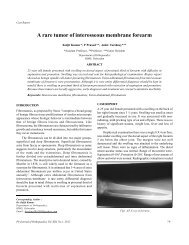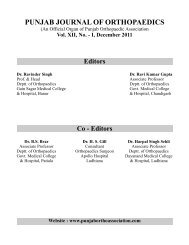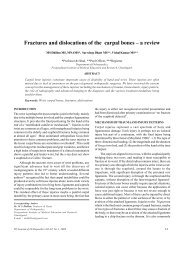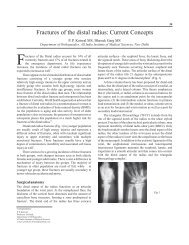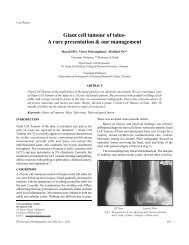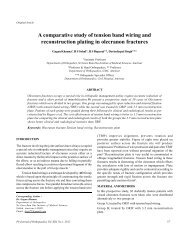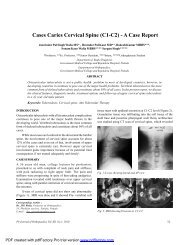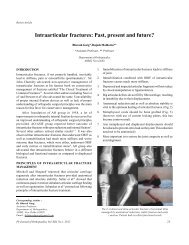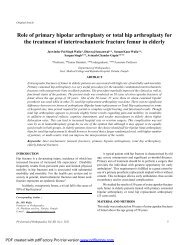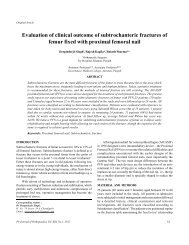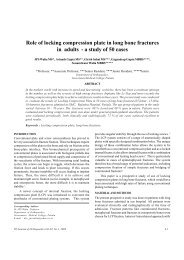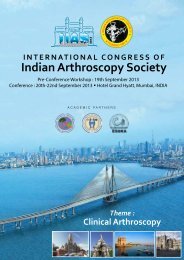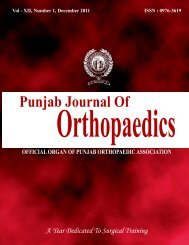Effectiveness of transcutaneous electrical nerve stimulation - Punjab ...
Effectiveness of transcutaneous electrical nerve stimulation - Punjab ...
Effectiveness of transcutaneous electrical nerve stimulation - Punjab ...
- No tags were found...
You also want an ePaper? Increase the reach of your titles
YUMPU automatically turns print PDFs into web optimized ePapers that Google loves.
Original Article<strong>Effectiveness</strong> <strong>of</strong> <strong>transcutaneous</strong> <strong>electrical</strong> <strong>nerve</strong> <strong>stimulation</strong> andinterferential electrotherapy in adhesive capsulitisAarti Dewan*, Rohit Sharma*** Assistant Pr<strong>of</strong>essorDepartment <strong>of</strong> Orthopedics,** Department <strong>of</strong> PhysiotherapySri Guru Ram Das Institute <strong>of</strong> Medical Sciences & Research,Amritsar, <strong>Punjab</strong>, INDIA.ABSTRACTA total <strong>of</strong> 50 subjects were randomly allocated to receive (i) trancutaneous <strong>electrical</strong> <strong>nerve</strong> <strong>stimulation</strong>(n=25) (ii) interferential electrotherapy (n=25) . Subjects in groups (i) and (ii) received 10 sessions <strong>of</strong> therespective treatment. Each subject's score on Range <strong>of</strong> Moition ,Constant Murley Assessment and visualanalogue scale were recorded at baseline, posttreatment session and subsequent followup sessions. Inboth the trancutaneous <strong>electrical</strong> <strong>nerve</strong> <strong>stimulation</strong> and interferential electrotherapy groups, the Range <strong>of</strong>Moition , Constant Murley Assessment score increased and the visual analogue scale score decreasedsignifcantly (both p < 0.0001), and signifcant difference was found between the 2 intervention groups(all p < 0.05). The observed improvement was well maintained in both intervention groups at least until the6month followup session. Both trancutaneous <strong>electrical</strong> <strong>nerve</strong> <strong>stimulation</strong> or interferential electrotherapyare effective in treating frozen shoulder patients. Interferential therapy is more effective in reducing painintensity and restoring shoulder function for people with adhesive capsulitis.Keywords: adhesive capsulitis, interferential therapy, <strong>transcutaneous</strong> <strong>electrical</strong> <strong>nerve</strong> <strong>stimulation</strong>INTRODUCTIONAdhesive capsulitis, also known as frozen shoulder, is one <strong>of</strong>the most frequent pathologies in the middle-aged population.The aetiology <strong>of</strong> frozen shoulder is unclear, possibly involvinga non-specifc chronic infammatory reaction <strong>of</strong> subsynovialtissue and resulting in capsular and synovial thickening, butthe problem affects the function <strong>of</strong> the glenohumeral joint 1-3 Itusually results in pain, decreased range <strong>of</strong> motion, and muscleweakness 4 . Persistent shoulder pain and compromised mobilitymay cause diffculty in performing activities <strong>of</strong> daily living oreven lead to disability 5 .Transcutaneous <strong>electrical</strong> <strong>nerve</strong> <strong>stimulation</strong> (TENS) is anon-invasive technique in which a low-voltage <strong>electrical</strong> currentis delivered through wires from a small power unit to electrodesCorresponding Author :Dr. Aarti Dewan*, MS (Orthopaeric Surgery)# 470, Basant Avenue, Amritsar, 143001, <strong>Punjab</strong>, INDIA.Fax: +91-0183-2587621Email: aartidew@gmail.comlocated on the skin 6 . TENS is <strong>of</strong>ten used to treat pain in variety<strong>of</strong> acute and chronic musculoskeletal conditions. 7-9 Recentreports, however, suggest that the absorption <strong>of</strong> calcific depositsin the shoulder muscle tendons is accelerated by low frequencyTENS therapy and may be related to increased microcirculationin the region <strong>of</strong> the <strong>stimulation</strong> 9-12 . Although no con-trolledstudies were identified to document those hypotheses, themost consistent and extensive pain relief appears to occur with<strong>stimulation</strong> <strong>of</strong> the acupuncture points thought to be associatedwith shoulder pain 13 .Interferential electrotherapy (IFE) is a commonphysiothera-peutic treatment modality used in Westerncountries. Its high carrier frequency (around 4000 Hz) produceslower impedance to the skin and allows deeper penetrationinto tissue 14 . IFE predominately excites large-diameter <strong>nerve</strong>fbres and reduces the transmission <strong>of</strong> nociceptive signalsthrough small-diameter <strong>nerve</strong> fbres to the spinal dorsal hornby presynaptic inhibition 15-16 , thus achieving pain modulationin the higher centre. Some studies have shown that IFE isPb Journal <strong>of</strong> Orthopaedics Vol-XII, No.1, 201164PDF created with pdfFactory Pro trial version www.pdffactory.com
Transcutaneous <strong>electrical</strong> <strong>nerve</strong> <strong>stimulation</strong> and interferentialelectrotherapy in adhesive capsulitiseffective in the manage-ment <strong>of</strong> various pain conditions 17-19 ,but not much work has been done on shoulder conditions.Theaim <strong>of</strong> the study is to find out whether TENS or IFT is effectivein per arthritis shoulder.MATERIAL AND METHODSStudy Design:The study is comparative in nature in which the effectiveness<strong>of</strong> TENS vs. Interferential therapy is seen in Periarthritisshoulder.Research SettingThe study was performed in the Department <strong>of</strong> Physiotherapyand Rehabilitation (Shri Guru Ram Das Institute <strong>of</strong> MedicalScience and Research), Vallah, Amritsar.ParticipantsMale & females subjects <strong>of</strong> Shri Guru Ram Das Institute <strong>of</strong>Medical Sciences and Research, Vallah, Amritsar formulatedthe population for this study. Representative sample <strong>of</strong> 70 males& females with unilateral shoulder affection who volunteeredto participate were taken, out <strong>of</strong> whom 50 samples who met theinclusion criteria were taken as experimental group. 25 patientsare in group I which are given interferential therapy and 25patients are in group II which are given <strong>transcutaneous</strong> <strong>electrical</strong><strong>nerve</strong> <strong>stimulation</strong>. Inclusive criteria were patients <strong>of</strong> Age Group40-60 yrs.who reported localized pain over one shoulder,experienced night pain and had restricted active and passiveshoulder motions. Exclusive criteria included Age GroupBelow 40 and above 60 ,a history <strong>of</strong> trauma, fractures, previousshoulder surgery, cervical or thoracic pain syndrome,complex regional pain syndrome, malignancies, on anticoagulanttherapy, Psychic patient, Hyper mobile joint or hadreceived acupuncture treatment to the painful shoulder in thepast 6 months. Written consent was obtained from allsubjects. The study was approved by the local ethicscommittee. The subjects were randomly allocated into: (i) theIFE group (n = 25); (ii) TENS group (n = 25)InterventionsINTERFERENTIAL THERAPY (IFT) GROUPThe subjects in this group received IFE treatment for 10sessions over 4 weeks. The patient is positioned comfortablyand the skin is prepared, washed and any skin lesion insulatedwith petroleum jelly. An IFE machine delivered current sweptfrom 80 to 120 Hz, and 4 suction-type electrodes were placedaround the shoulder region used in two pairs, (quadripolartechnique is applied) each pair being indicated by the colorings<strong>of</strong> the wire from the machine. The electrodes <strong>of</strong> each pair areplaced diagonally opposite one another in such a way that theinterference effect is produced in the tissues where it is required,which is very deep. The patient is warned that he will feel atingling sensation which should not be too uncomfortable orburning.The intensity <strong>of</strong> the <strong>stimulation</strong> was adjusted to just belowthe pain threshold and the <strong>stimulation</strong> lasted for 20 minutes.TRANSCUTANEOUS ELECTRICAL NERVE STIMULATION(TENS) GROUPAll the subjects in this group received TENS treatment for10 sessions over a 4-week period (2-3 times a week)The skinin the treatment area was frst sterilized with an isopropylalcohol skin wipe. Conductive rubber electrodes covered witha conductive gel in order to gain good skin contact re placedon the patient's skin. The electrodes can be bandaged onto thepatient or fixed with adhesive tape. Four electrodes are placedfor the treatment <strong>of</strong> periarthritis, we used high frequency TENSin our study. The intensity <strong>of</strong> the <strong>stimulation</strong> was adjusted to atolerance level <strong>of</strong> just below the pain threshold. Large mainunits are available to produce the current, but <strong>of</strong>ten small unitmade to be placed in the patient's pocket and utilizing batteriesare preferred.Pulses <strong>of</strong> around 0.2 ms at about 100Hz are given atintensities that provoke gentle contraction. The patient shouldfeel a tingling pins and needle sensation. This stimulates thehigh threshold 'A' delta and 'C' fibres leads to release <strong>of</strong>endogenous opiods afferents which reduces pain. It is appliedto acupuncture points but is sometime applied to motor points<strong>of</strong> muscles. The intensity <strong>of</strong> the <strong>stimulation</strong> was adjusted to atolerance level <strong>of</strong> just below the pain threshold. The needlewas retained for 20 min, and was manually lifted and thrustedevery 10 min.OUTCOME MEASURESRange <strong>of</strong> motionGoniometry is measurement <strong>of</strong> angles created at human jointby the bones <strong>of</strong> the body. The instrument used for thisMeasurement is known as Goniometer. The patient joint isplaced in a starting position <strong>of</strong> Zero degree then permit thepatients to move the joint through available range <strong>of</strong> motionand measure the angle. Goniometeric measurementsare recorded in numerical table and range <strong>of</strong> motionmeasured.Pb Journal <strong>of</strong> Orthopaedics Vol-XII, No.1, 201165PDF created with pdfFactory Pro trial version www.pdffactory.com
Transcutaneous <strong>electrical</strong> <strong>nerve</strong> <strong>stimulation</strong> and interferentialelectrotherapy in adhesive capsulitisIn patients treated with IFT, pre-treatment VAS scorewas 7.50 and after the treatment the score was reduced at 2.15,showing highly significant differences (p 0.0001) between thepre and post score (t=29.44). In patients treated with TENS,pre-treatment VAS score was 7.70 and after the treatment thescore was reduced to 5.10, showing highly significantdifferences (p 0.0001) between the pre and post score(t=13.17).Pain Scale Readting9876543210Graph <strong>of</strong> Mean <strong>of</strong> Pain Score between IFT andTENS7.5 7.7IFT2.15Pre Treatment ScoreFig. 1: Mean pain score with IFT and TENSTable 2 shows the mean differences <strong>of</strong> pain scores measuredby Visual Analog Scale in patients treated with IFT andTENS. The patients treated with IFT shows higher meandifferences (5.35) than patients treated with TENS (2.60)showing highly significant differences (p 0.0001) between them(t=10.25).Table 25.1TENSRange <strong>of</strong> Motion200180160140120100806040200Graph <strong>of</strong> Mean <strong>of</strong> Range <strong>of</strong> Motion for Flexion148.572 71.5IFTPre Treatment ROMPost Treatment ROMTENSFig. 2: Mean range <strong>of</strong> motion <strong>of</strong> flexionTable 3 shows the distribution <strong>of</strong> scores <strong>of</strong> range <strong>of</strong> Motion(ROM) <strong>of</strong> flexion in patients treated with IFT and TENS(Figure 2). In patients treated with IFT, pre treatment ROMscore was 72.00 and the post treatment score was increased by148.50 showing highly significant differences (p 0.0001)between the pre and post score (t=22.09). In patient treatedwith TENS, pre treatment ROM score was 71.50 and posttreatment score was increased to 99.00 showing highlysignificant differences (p 0.0001) between the pre and postscore (t=15.64).Table 399Scores <strong>of</strong> Range <strong>of</strong> motion <strong>of</strong> flexion patients intreated with IFT and TENSMean differences <strong>of</strong> scores <strong>of</strong> Visual Analog Scales inpatients treated with IFT and TENSScores Differences t-value p-valueMean S.D. S.E.IFT 5.35 ±0.81 0.18 10.25 p 0.0001TENS 2.60 0.80 0.20RANGE OF MOTIONFlexionTable 4 shows the mean differences <strong>of</strong> scores <strong>of</strong> range<strong>of</strong> motion <strong>of</strong> flexion in patients treated with IFT and TENS.The patients treated with IFT shows higher mean difference(76.50) than in patients treated with TENS. (27.50) showinghighly significant differences (p≤0.0001) between them(t=12.62).Pb Journal <strong>of</strong> Orthopaedics Vol-XII, No.1, 201167PDF created with pdfFactory Pro trial version www.pdffactory.com
Dewan and SharmaTable 4Mean differences <strong>of</strong> scores <strong>of</strong> range <strong>of</strong> motion <strong>of</strong> flexion inpatients treated with between IFT and TENSScores Differences t-value p-valueMean S.D. S.E.IFT 76.50 15.48 3.46 12.62 p 0.0001TENS 27.50 7.86 1.76Table 5Scores <strong>of</strong> Range <strong>of</strong> motion for abduction in patients intreated with IFT and TENSPre Treatment Reading Post Treatment Reading tvalueMean S.D. S.E. Mean S.D. S.E.pvalueIFT 74.45 22.56 5.05 154.0 14.29 3.20 20.17 p≤0.0001TENS 78.00 20.35 4.55 104.00 16.35 3.66 14.17 p≤0.0001ABDUCTIONTable 5 shows the distribution <strong>of</strong> scores <strong>of</strong> Range <strong>of</strong> motion(ROM) <strong>of</strong> abduction in patients treated with IFT and TENS(Figure 3). In patients treated with IFT, pre-treatment ROMscore was 74.75 and the post treatment score was increased to154.0 showing highly significant differences (p 0.0001) betweenthe pre and post treatment score (t=20.17). In patients treatedwith TENS pre-treatment ROM score was 78.00 and posttreatment score was increased to 104.00 showing highlysignificant differences (p 0.0001) between the pre and postscore (t=14.17).Range <strong>of</strong> Motion180160140120100806040200Graph <strong>of</strong> Mean <strong>of</strong> Range <strong>of</strong> Motion for Abduction15474.75 78IFTPre Treatment ROMTENS104Post Treatment ROMFig. 3: Mean range <strong>of</strong> motion <strong>of</strong> abductionTable 6 shows the mean difference <strong>of</strong> scores <strong>of</strong> range <strong>of</strong>motion <strong>of</strong> abduction in patients treated with IFT and TENS.The patients treated with IFT shows higher mean difference(78.75) than patients treated with TENS (26.00) showinghighly significant differences (p 0.0001) between them(t=11.78).Table 6Mean differences <strong>of</strong> scores <strong>of</strong> range <strong>of</strong> motion <strong>of</strong>abduction in persons treated with IFT and TENSScores Differences t-value p-valueMean S.D. S.E.IFT 78.75 18.27 4.09 11.78 p 0.0001TENS 26.00 8.21 1.84EXTERNAL ROTATIONTable 7 shows the distribution <strong>of</strong> scores <strong>of</strong> Range <strong>of</strong> motion(ROM) <strong>of</strong> external rotation in patients treated with IFT andTENS (Figure 4). In patients treated with IFT, pretreatment range <strong>of</strong> motion (ROM) score was (21.75) andpost treatment score was increased to (65.50) showinghighly significantly differences (p 0.0001) between thepre and post score (t=22.45). In patient treated withTENS, pre treatment ROM score was (23.00) and posttreatmentscore was increased to 34.00 showing highlysignificant differences (p 0.0001) between the pre and postscore (t=10.34).Pb Journal <strong>of</strong> Orthopaedics Vol-XII, No.1, 201168PDF created with pdfFactory Pro trial version www.pdffactory.com
Transcutaneous <strong>electrical</strong> <strong>nerve</strong> <strong>stimulation</strong> and interferentialelectrotherapy in adhesive capsulitis26. Basbaum AI, Fields HL. Endogenous pain control systems:brainstem spinal pathways and endorphin circuitry. Annu RevNeurosci 1984; 7: 309–338.27. Johnson MI, Ashton C.H Thomson J.W. (2006). An in depth study<strong>of</strong> long term uses <strong>of</strong> <strong>transcutaneous</strong> <strong>electrical</strong> nerse <strong>stimulation</strong>(TENS). Implications for clinical use <strong>of</strong> TENS, Pain 44, 221-9.28. Somers and Somers (2007). Relevance <strong>of</strong> <strong>transcutaneous</strong> <strong>electrical</strong><strong>nerve</strong> <strong>stimulation</strong> parameters to neurophysio-logical effects.Proceedings, 12 th International congress <strong>of</strong> world confederationsfor Physical Therapy, p.576.29. Van der Heijden GJ, Leffers P, Wolters PJMC, Verheijden JJD, vanMameren H, Houben JP, et al. No effect <strong>of</strong> bipolar interferentialelectrotherapy and pulsed ultrasound for s<strong>of</strong>t tissue shoulder disorders:a randomized controlled trial. Ann Rheum Dis 1999; 58:530–540.30. Cheing GLY, Hui-Chan CWY. Analgesic effects <strong>of</strong> <strong>transcutaneous</strong><strong>electrical</strong> <strong>nerve</strong> <strong>stimulation</strong> and interferential currents on heat painin healthy subjects. J Rehabil Med 2003; 35: 15–19.31. Low J, Reed A, editors. Electrotherapy explained. Principle andpractice. 2nd edn. Oxford: Butterworth Heinemann; 1998.Pb Journal <strong>of</strong> Orthopaedics Vol-XII, No.1, 201171PDF created with pdfFactory Pro trial version www.pdffactory.com



